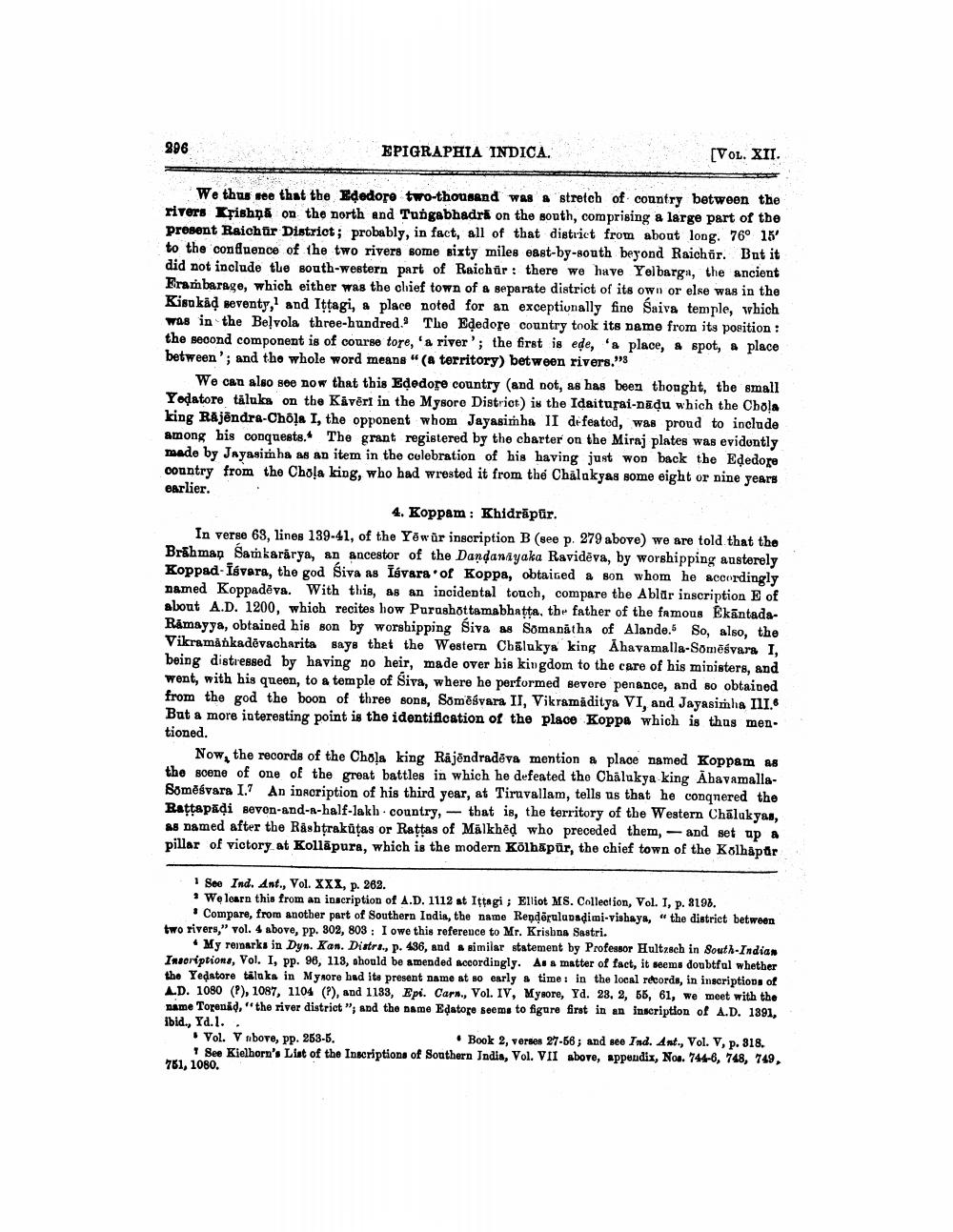________________
296
EPIGRAPHIA INDICA.
[VOL. XII.
We thus see that the Ededore two-thousand was a stretch of country between the rivers Krishna on the north and Tungabhadra on the south, comprising a large part of the present Raichur District; probably, in fact, all of that district from about long. 76° 15' to the confluence of the two rivers some sixty miles east-by-south beyond Raichur. But it did not include the south-western part of Raichur: there we have Yelbarga, the ancient Frambarage, which either was the chief town of a separate district of its own or else was in the Kisukaḍ seventy, and Iṭṭagi, a place noted for an exceptionally fine Saiva temple, which was in the Belvola three-hundred. The Eḍedore country took its name from its position: the second component is of course tore, 'a river'; the first is eḍe, 'a place, a spot, a place. between'; and the whole word means "(a territory) between rivers."
We can also see now that this Eḍedore country (and not, as has been thought, the small Yedatore taluka on the Kavert in the Mysore District) is the Idaiturai-naḍu which the Chola king Rajendra-Chola I, the opponent whom Jayasimha II defeated, was proud to include among his conquests. The grant registered by the charter on the Miraj plates was evidently made by Jayasimha as an item in the celebration of his having just won back the Ededore country from the Chola king, who had wrested it from the Chalukyas some eight or nine years earlier.
4. Koppam: Khidrāpür.
In verse 63, lines 139-41, of the Yewür inscription B (see p. 279 above) we are told that the Brahman Samkararya, an ancestor of the Dandanayaka Ravideva, by worshipping austerely Koppad-Isvara, the god Śiva as Iévara of Koppa, obtained a son whom he accordingly named Koppadeva. With this, as an incidental touch, compare the Ablar inscription E of about A.D. 1200, which recites how Purushottamabhatta, the father of the famous EkantadaRamayya, obtained his son by worshipping Siva as Somanatha of Alande. So, also, the Vikramankadevacharita says that the Western Chalukya king Ahavamalla-Somesvara I, being distressed by having no heir, made over his kingdom to the care of his ministers, and went, with his queen, to a temple of Siva, where he performed severe penance, and so obtained from the god the boon of three sons, Somesvara II, Vikramaditya VI, and Jayasimha III. But a more interesting point is the identification of the place Koppa which is thus mentioned.
Now, the records of the Chola king Rajendradeva mention a place named Koppam as the scene of one of the great battles in which he defeated the Chalukya king AhavamallaSomesvara I. An inscription of his third year, at Tiruvallam, tells us that he conquered the Baṭṭapaḍi seven-and-a-half-lakh country, that is, the territory of the Western Chalukyas, as named after the Rashtrakutas or Raṭṭas of Mälkhed who preceded them, and set up a pillar of victory at Kollapura, which is the modern Kölhapur, the chief town of the Kolhapur
1 See Ind. Ant., Vol. XXX, p. 262.
We learn this from an inscription of A.D. 1112 at Ittagi; Elliot MS. Collection, Vol. I, p. 3196.
Compare, from another part of Southern India, the name Renderulunadimi-vishaya, "the district between two rivers," vol. 4 above, pp. 302, 803: I owe this reference to Mr. Krishna Sastri.
My remarks in Dyn. Kan. Distrs., p. 436, and a similar statement by Professor Hultzsch in South-Indian Inscriptions, Vol. I, pp. 96, 113, should be amended accordingly. As a matter of fact, it seems doubtful whether the Yedatore täluka in Mysore had its present name at so early a time: in the local records, in inscriptions of A.D. 1080 (P), 1087, 1104 (P), and 1133, Epi. Cars., Vol. IV, Mysore, Yd. 28, 2, 55, 61, we meet with the name Torenad, "the river district"; and the name Edatore seems to figure first in an inscription of A.D. 1391, ibid., Yd.1.
Vol. V above, pp. 253-5.
Book 2, verses 27-56; and see Ind. Ant., Vol. V, p. 318. See Kielhorn's List of the Inscriptions of Southern India, Vol. VII above, appendix, Nos. 744-6, 748, 749,
751, 1080.




